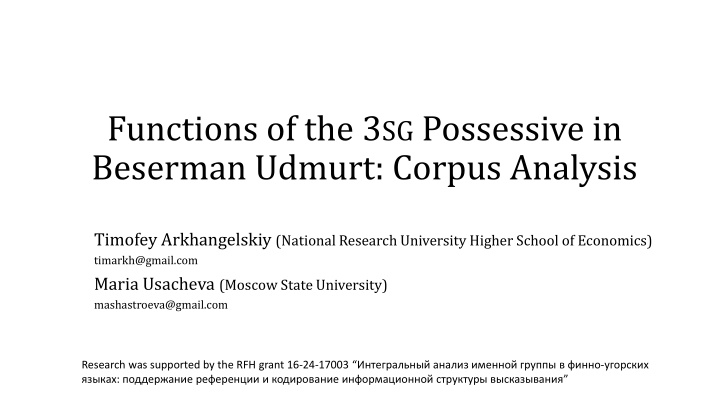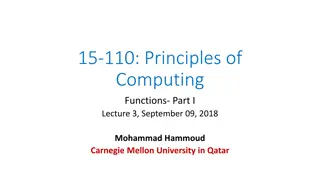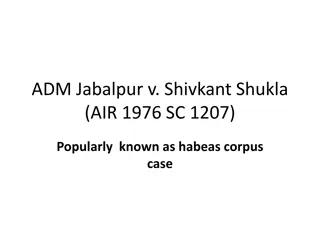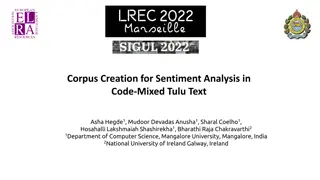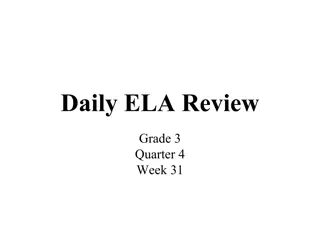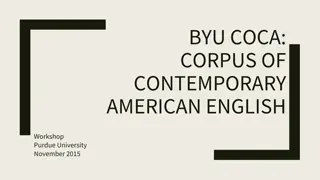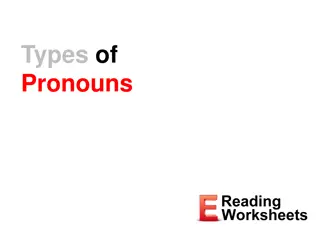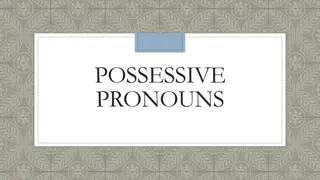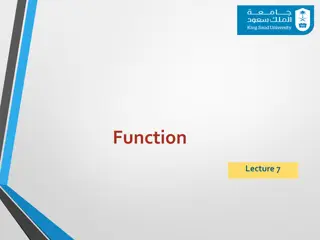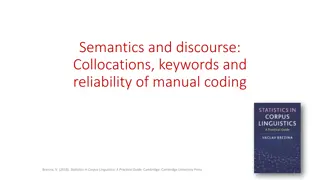Analysis of 3SG Possessive Functions in Beserman Udmurt Corpus
Beserman Udmurt's 3SG possessive holds significance beyond typical possessive relations, often serving non-possessive functions like marking contrastive focus. This study delves into the diverse functions of the 3SG possessive in Udmurt through corpus analysis, exploring its evolution into a definiteness marker and its discourse roles, supported by machine learning algorithms applied to annotated texts from the Beserman corpus.
Download Presentation

Please find below an Image/Link to download the presentation.
The content on the website is provided AS IS for your information and personal use only. It may not be sold, licensed, or shared on other websites without obtaining consent from the author.If you encounter any issues during the download, it is possible that the publisher has removed the file from their server.
You are allowed to download the files provided on this website for personal or commercial use, subject to the condition that they are used lawfully. All files are the property of their respective owners.
The content on the website is provided AS IS for your information and personal use only. It may not be sold, licensed, or shared on other websites without obtaining consent from the author.
E N D
Presentation Transcript
Functions of the 3SG Possessive in Beserman Udmurt: Corpus Analysis Timofey Arkhangelskiy (National Research University Higher School of Economics) timarkh@gmail.com Maria Usacheva (Moscow State University) mashastroeva@gmail.com Research was supported by the RFH grant 16-24-17003 - :
Possessives in Udmurt Udmurt has full paradigm of possessives 3SG possessive is special, as apart from having purely possessive functions (see 2010), it often means something other than a prototypical possessive relation Only 3SG possessive is used in case compounding and for marking contrastive focus on adjectives: (1)kyz-ze / thick-P.3SG.ACC / thick-P.2SG.ACC log-P.2SG.ACC Put the thick log to the bottom. *kyz-de kor-de uli-ja-z bottom-ILL-P.3SG put.IMP pun
3SG possessive The fact that P.3SG has developed non-possessive meanings in Udmurt and other Uralic languages has been often mentioned in the literature [ et al. 1974], [ 1962:84-85], [Winkler 2001: 29], [ 1970: 176] [ 2012] [Simonenko 2014] for Komi, Khanty and Mari [T nczos 2016] Sometimes P.3SG evolves into a definiteness marker (cf. Eastern Armenian)
3SG possessive Example of a 3SG possessive with a discourse function: (2) pios.murt-ez guy-P.3SG The guy took a loaf. ba t-iz take-PST.3SG baton loaf It can attach to different parts of speech, but we only looked at nouns (including relational nouns)
Other possessives 2SG possessives can also be used in non-possessive functions: (3)vaj so-ize=no bring.IMP that-P.3SG.ACC=ADD Bring me that rope as well [the rope does not belong to the addressee] goz -de rope-P.2SG.ACC And, occasionally, 1SG possessives as well: (4)ad ami-je k eke korka person-P.1SG some That man [I was talking about] went into some house. p r-iz enter-PST.3SG house.ILL We will not cover this topic here
What we did We want to know when and how often P.3SG marker has non- possessive functions and what are the factors that trigger its appearance We annotated 12 texts of different genres from the Beserman corpus (collected in Shamardan, Udmurtia, in 2003 2016), which gave us about 2,000 nouns Each noun was annotated with a number of parameters (features) Then machine learning algorithms were used to see how well this set of parameters predicts the appearance of P.3SG and which parameters are most important
What we did [Serdobolskaya, Toldova 2012] for Pechora Komi:
Features referential status (def, weak, ref_indef, indef, generic,...) semantic class (rn, bp, kin, ..., other) animacy alienability uniqueness syntactic position (subj, DO, oblique, NPDep, addr, pred) topic / focus referential distance, distance to first occurrence, topic persistence the case of the dependent (if any) protagonism possessive relation
NP structure Two types of NPs with nominal dependents are possible in Beserman: N N (5)korka house N-GEN N-P.3SG (6)korka-len house-GEN ko ag window ko ag-ez window-P.3SG
NP structure With relational nouns as heads, the (discourse) possessive marker in N N can attach to the head or the dependent: (7)korka-je dor-e / korka house-P.1SG near-ILL / house to my house In N-GEN N-P.3SG, it can attach only to the dependent, as the slot on the head is already occupied: (8)korka-je-len dor-a-z house-P.1SG-GEN near-ILL-P.3SG to my house dor-a-m near-ILL-P.1SG
NP structure We counted [N RelN] as one occurrence: korka korkajez korka+v l n korkajez+v l n korka+v laz korkajezlen+v laz 0 3sg 0 3sg 3sg 3sg
NP structure Ordinary nouns: 1468 total, 75% non-possessive RelNPs: 130 total, 77% non-possessive It seems that possessive marking is independent from the NP type and from the choice of the host within [N RelN] Annotating heads and dependents in RelNPs separately would skew the results
Distribution of possessives in texts no possessive: 65.6% 1: 2: 3: 3.9% 2.5% 28% It is often hard to tell whether any given occurrence of P.3SG is possessive or discourse : true possessive : 24% discourse possessive : 60% ???: 16%
True possessives The genitive case of the dependent always triggers the appearance of the possessive marker Well, almost always: (9)sakar odig k l -iz=na sugar one remain-PST.3SG=else as for the sugar, I have only one left In all 3 examples we have, the head is in the topic That said, we discard true possessives and only look at the rest m nam I.GEN
Overall prediction quality Machine learning: an algorithm looks at the annotated data ( training dataset ) and tries to learn rules so that it could predict the target variable (whether discourse P.3SG appears on a noun) based on other parameters After that, we check how well the rules have been learned by applying them against a separate test sample We applied 3 algorithms: SVM, decision tree, random forest SVM and random forest give 84% correct answers Therefore, our set of parameters explains when the P.3SG appears fairly well, but there are probably some other factors or free variation
Feature importance 1. semantic class (0.23) 2. referential status (0.19) 3. referential distance (0.17) 4. uniqueness (0.13) 5. syntactic position (0.11) ...
Feature importance alienability, animacy, protagonism, distance to the first mention proved to be irrelevant topic persistence gave inconsistent results with different window lengths topicality seems to be important (66% non-possessives in topic, 77% in focus), but we have low inter-annotator agreement
Animacy Animacy was found to be important for the choice of ACC/0 marking of the DO in Pechora Komi (Serdobolskaya, Toldova 2012) In our model its predictive strength was very low No hierarchy: people > inanimate >> animate Other factors seem to interfere (toy animals/people; animals as protagonists in fairy tales)
Syntactic position The probability of being marked decreases along the hierarchy: no possessive P.3SG 35% 65% subject 71% 29% direct object 78% oblique 22% 90% nominal dependent 10%
Definiteness Whether the referential status of a noun is definite is important Nouns that are not definite usually (93.5%) do not have possessive Still, 60% of definite nouns also do not have possessives (50% if you count the true possessives ) Is it the case that P.3SG is blocked by other factors (as e.g. in English the definite article is incompatible with demonstrative pronouns and is not used with proper nouns)?
Definiteness: demonstratives Demonstrative pronouns in Uralic languages usually block discourse possessive marking (folklore) This is not the case in Beserman: no possessive P.3SG 61% 39% with so that / ta this 60% 40% definite without so/ta
Definiteness: uniqueness Items that refer to unique objects usually do not have possessive marking (more or less) globally unique: sun, police, army unique in the given context (the village or the river when describing the life in that village or during experiments) 92% nouns in each of the two classes are used without possessives
Definiteness: proper names In our sample, all 68 proper names are used without possessives In fact, using P.3SG with proper names is not prohibited: (10) kakoj, (RUS) [Have you seen Lada s daughter?] I haven t even seen Lada herself yet! mon I.NOM lada-ze PN-P.3SG.ACC NEG.PST.1SG=yet ej=na a - l! see-ITER But P.3SG is used here for reasons other than marking definiteness
Definiteness Even if we remove unique objects and proper names from the sample, still 42% of definite nouns will not be marked Therefore, P.3SG cannot be described as the definiteness marker Out of these, subjects and direct objects are more likely to be marked
Topicality and referential distance The P.3SG marker attaches to topic nouns more frequently This trend is even more pronounced for subjects Referential distance: number of clauses between the current and the previous mention of the object in discourse With the increase if the distance, the object loses its activation
Topicality and referential distance It is evident that difference between, say, 15 and 16 clauses is less significant than between 2 and 3 We divided this parameter into segments of exponentially growing lengths: 0 1 2 3 4 5 6 7 8 segment 0 1 2-3 4-7 8-13 14-23 24-40 41-68 69-... ref. dist.
Topicality and referential distance True referential distance in clauses (smoothing by averaging over neighbors: at least 30 nouns for each point) 0.6 0.5 0.4 0.3 0.2 0.1 0 0 10 20 30 40 50
Topicality and referential distance Referential distance in distance classes 0.45 0.4 0.35 0.3 0.25 0.2 0.15 0.1 0.05 0 0 2 4 6 8 10
Topicality and referential distance The probability of possessive marking increases as referential distance increases from 0 through 2 (24% 40%), then stays at the same level, and then drops little by little This indicates that P.3SG is used to reactivate the object that was mentioned at some point earlier, but lost its activation This can happen to both definite and indefinite nouns Nouns that need such reactivation are often topical The drop on greater distances can be explained by the fact that if the object was last mentioned too long ago, it loses its activation completely and has to be reintroduced
Contrast P.3SG is very frequent in contrastive focus: (11)a gord ma ina-ez-len odig pal and red car-P.3SG-GEN [They also opened both doors of the white car.] And is one of the red car s doors open? Among nouns that denote one object out of a small set, only 31% lacked possessive marking In such cases, P.3SG can be described as having possessive semantics, this set being interpreted as the possessor es-ez door-P.3SG pa =uk? open=EMPH one side
Conclusions - 1 discourse P.3SG is more frequent than the possessive one There is no single parameter that explains its use Referential status, semantic class of the noun, syntactic position, referential distance, uniqueness, and topicality predict the appearance of P.3SG with 84% accuracy Animacy, alienability, topic persistence, and distance to first mention do not influence the probability of P.3SG marking Assignment of P.3SG to a RelNP seems to be independent from the choice of the host within that phrase
Conclusions - 2 Referential status of the noun is important, but P.3SG has not yet evolved into a definiteness marker P.3SG is used for reactivating the topic that was mentioned previously but lost activation (even for indefinite nouns), especially if it is in the subject position P.3SG is used in contrastive contexts, where it can be interpreted as marking a possessive relation with respect to a small set
References Serdobolskaya, N., Toldova, S. Information structure at odds with discourse factors: evidence from Finno-Ugric differential object marking. Handout of the talk given at Categories of Information Structure across Languages, Nijmegen, Netherlands, 9.11.2012 10.11.2012. Simonenko, A. Microvariation in Finno-Ugric Possessive. In Proceedings of the 43rdannual meeting of the North East Linguistic Society, Vol. 2, pp. 127-140, 2014. T nczos, O. Towards a unified account of the suffix -ez/jez in Udmurt. Talk at SLE 2016 Winkler E. Udmurt, vol. 212 of Languages of the World. Lincom Europa, Munich, 2001 , . . PhD thesis. Tartu likooli Kirjastus, 2010. , . . : // . . ( . .). - : . .: 2012. , . ., , . ., , . ( . .). - ( - ). : , 1974. . . ( . .). . . : , 1962. . . . .: , 1970. Corpus of spoken Beserman: http://beserman.ru/corpus/
